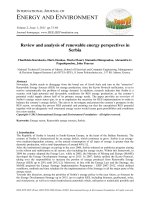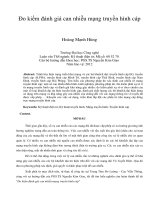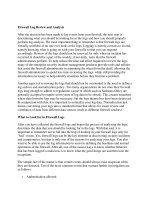PCO WASTEWATER SAMPLING AND ANALYSIS
Bạn đang xem bản rút gọn của tài liệu. Xem và tải ngay bản đầy đủ của tài liệu tại đây (1.32 MB, 53 trang )
EMB-National Capital Region (EMB-NCR) Pollution Control Officers (PCOs)
Training
February 12, 2009
WATER/WASTEWATER
SAMPLING AND ANALYSES
Engr. Mavic S. Quides
DENR-EMB-NCR
2009
03/01/21
1
SAMPLING DEFINITION &
OBJECTIVE, PURPOSE/S
What is SAMPLING? ...
collection of truly representative samples which
when analyzed yield results reflecting actual quality
of the water samples
Objective
:
To collect a portion of material small enough in volume to be
transported conveniently and handled in the laboratory while still
accurately representing the material being sampled
Purpose/s
Compliance with regulatory requirements
:
Evaluation of performance efficiency of WTP system
Evaluation of effectiveness of in-house waste
minimization measure/s
03/01/21
2
SAMPLING STATIONS
Influent
– Collected at points at highly turbulent flow and
upstream/above of plant return lines
Effluent
– Collected at the most representative point downstream
of all treated or untreated combined wastewater
streams before entering the receiving waters
Mixing Zone
– The average length of the mixing zone from the
point source is approx. five (5) times of the effective
width of the receiving water
Others
– Outfalls suspected discharging pollutive WW
– Effluent Streams from each treatment units.
03/01/21
3
TYPES OF SAMPLES
Grab or Catch
– A sample collected at a particular time and
place can represent only the composition of the
source at that time and place
Composite
– Combination of grab samples collected at the
same sampling point at different times
03/01/21
4
SAMPLE HANDLING
COMPONENTS
✔ Container Requirements
Plastic or Glass(one may be preferred over the other
depending on the type of parameters)
✔ Preservation Methods
Refrigeration (Cool @ 4oC)
Chemical Addition
- Acidification (pH adjust <2)
- Biocides (HgCl soln)
- Special Cases (NaOH for CN- analysis)
✔ Maximum Holding Time
03/01/21
5
SUMMARY OF SPECIAL SAMPLING
OR HANDLING REQUIREMENTS
DETERMINATION
Container
Minimum
Sample Sample
Size
Type
mL
Acidity
Alkalinity
BOD
Boron
Bromide
Carbon, organic,
total
Carbon dioxide
COD
P,G (B)
P, G
P, G
P
P, G
G
100
200
1000
100
100
100
g
g
g
g, c
g, c
g, c
P, G
P, G
100
100
g
g, c
Chloride
Chlorine, residual
Chlorine dioxide
Chlorophyll
Color
Conductivity
Cyanide:
Total
P, G
P, G
P, G
P, G
P, G
P, G
50
500
500
500
500
500
P, G
500
Preservation
Maximum
Storage
Recommended/
Regulatory
24h/14d
25h/14d
6h/48h
28d/6mos
28d/28d
7d/28d
g, c
g
g
g, c
g, c
g, c
Refrigerate
Refrigerate
Refrigerate
None required
None required
Analyze immediately; or refrigerate and
add H3PO4 or H2SO4 to pH<2
Analyze immediately
Analyze as soon as possible, or add
H2SO4 to pH<2; refrigerate
None required
Analyze immediately
Analyze immediately
30d in dark
Refrigerate
Refrigerate
g, c
Add NaOH to pH>12, refrigerate
24h/14d;24h if
Sulfide present
stat/N.S.
7d/28d
28d
0.5h/stat
0.5h/N.S.
30d/N.S.
48h/28h
28d/28d
Clesceri, Eaton & Greenberg "Standard Methods for the Examination of Water and Wastewater" 19th Ed. 1995 pges. 1-22 to 1-23
03/01/21
6
SUMMARY OF SPECIAL SAMPLING
OR HANDLING REQUIREMENTS
DETERMINATION
Container
Minimum
Sample Sample
Size
Type
mL
Preservation
Maximum
Storage
Recommended/
Regulatory
Cyanide amenable to
chlorination
Fluoride
Hardness
Iodine
Metals, general
P, G
500
g, c
P
P, G
P, G
P(A), G(A)
300
100
500
500
g, c
g, c
g, c
g
Chromium VI
Cu by colorimetry*
Mercury
Nitrogen:
Ammonia
P(A), G(A)
300
g
P(A), G(A)
500
g, c
Add HNO3 to pH<2, 4 C
28d/28d
P, G
500
g, c
7d/28d
P, G
100
g, c
Nitrate+Nitrite
P, G
Nitrite
P, G
Organic, Kjeldahl* P, G
200
100
500
500
g, c
g, c
g, c
g
Analyze as soon as possible, or add
H2SO4 to pH<2; refrigerate
Analyze as soon as possible, or
refrigerate
Add H2SO4 to pH<2, refrigerate
Analyze ASAP or refrigerate
Refrigerate; add H2SO4 to pH<2
Analyze ASAP, refrigerate
6h/N.S.
Nitrate
Odor
G
Add 100 mg Na2S2O3/L
stat/14d;24h if
sulfide present
None required
28d/28d
Add HNO3 to pH<2
6mos/6mos
Analyze immediately
0.5h/N.S.
For dissolved metals filter immediately 28d/28d
add HNO3 to pH<2
Refrigerate
24h/24h
0
48h/48h (28d for
chlorinated sples)
none/28d
none/48h
7d/28d
Clesceri, Eaton & Greenberg "Standard Methods for the Examination of Water and Wastewater" 19th Ed. 1995 pges. 1-22 to 1-23
03/01/21
7
SUMMARY OF SPECIAL SAMPLING
OR HANDLING REQUIREMENTS
DETERMINATION
Oil and Grease
Container
G,wide-mouth
calibrated
Organic Compounds:
MBAS
P,G
Pesticides
G(S),TFE-lined
cap
Phenols
P, G
Purgeables* by G, TFE-lined
purge and trap
cap
Minimum
Sample Sample
Size
Type
mL
Preservation
Maximum
Storage
Recommended/
Regulatory
1000
g, c
Add HCl to pH<2, refrigerate
28d/28d
250
1000
g, c
g, c
500
g, c
Refrigerate
Refrigerate;add 1000mg ascorbic
acid/L if residual chlorine present
Refrigerate, add H2SO4 to pH<2
48h
7d/7d until extraction;
40d after extraction
*/28d
2x40
g
Refrigerate; add H2SO4 to pH<2; add
1000mg ascorbic acid/L if residual
chlorine present
7 d/14 d
300
g
Analyze immediately
Titration be delayed after acidification
Analyze immediately
Analyze immediately
For dissolved phosphate filter
immediately; refrigerate
Analyze immediately or use wax seal
Refrigerate, do not freeze
0.5h/stat
8h/8h
0.5 h/N.S.
2h/stat
48h/N.S.
Oxygen, Dissolved:
Electrode
Winkler
Ozone
pH
Phosphate
G, BOD bottle
G
P, G
G(A)
1000
50
100
g
g
g
Salinity
Silica
G, wax seal
P, G
240
200
g
g, c
6mos/N.S.
28d/28d
Clesceri, Eaton & Greenberg "Standard Methods for the Examination of Water and Wastewater" 19th Ed. 1995 pges. 1-22 to 1-23
03/01/21
8
SUMMARY OF SPECIAL SAMPLING
OR HANDLING REQUIREMENTS
DETERMINATION
Container
Minimum
Sample Sample
Size
Type
mL
Preservation
Silica
Sludge digester gas
Solids
P, G
G, gas bottle
P, G
200
g, c
Refrigerate, do not freeze
200
g
g, c
Refrigerate
Sulfate
Sulfide
P, G
P, G
100
100
g, c
g, c
Taste
Temperature
Turbidity
G
P, G
P, G
500
g
g
100
Refrigerate
Refrigerate; add 2 drops 2N Zn
Acetate/100mL; add NaOH to pH>9
Analyze ASAP; refrigerate
Analyze immediately
Analyze same day; store in dark
Maximum
Storage
Recommended/
Regulatory
28d/28d
N.S.
7d/2-7d; see cited
reference
28d/28d
28d/7d
24h/N.S.
stat/stat
24h/48h
Clesceri, Eaton & Greenberg "Standard Methods for the Examination of Water and Wastewater" 19th Ed. 1995 pges. 1-22 to 1-23
03/01/21
9
SIGNIFICANT PARAMETERS FOR
SELECTED TYPES OF INDUSTRIES
TYPE OF INDUSTRY
SIGNIFICANT PARAMETERS
A.
BEVERAGE INDUSTRY
BOD5, pH, Total Suspended Solids (TSS),
Settleable Solids, Oil and Grease (O/G)
B.
CEMENT CONCRETE
pH, TSS, Total Dissolved Solids (TDS), Temp.
C.
DAIRY PRODUCT PROCESSING
BOD5,COD, pH, TSS, TDS, Settleable Solids
D.
DISTILLERY
BOD,COD, pH, TSS, Settleable Solids, Temp.
E.
FERROALLOY MFG.
TSS, Chromium (VI), O/G
(electric furnace w/ wet APC)
F.
G.
FERTILIZER INDUSTRY
Chloride, Chromium, TDS, Nitrate, TSS
Nitrogen Fertilizer Industry
Phosphate Fertilizer
pH, Phosphorous, Suspended Solids
Temperature, Cadmium, Arsenic
FLOUR & STARCH INDUSTRY
BOD5 pH, Suspended Solids, Temperature
WATER QUALITY MONITORING MANUAL, Environmental Management Bureau, DENR, 1994.
03/01/21
10
SIGNIFICANT PARAMETERS FOR
SELECTED TYPES OF INDUSTRIES
TYPE OF INDUSTRY
SIGNIFICANT PARAMETERS
H.
INORGANIC CHEMICALS,
ALKALIES AND CHLORINE
INDUSTRY
pH, TSS, TDS, Chlorides, Sulfates, COD, Temp
I.
LEATHER TANNING & FINISHING
INDUSTRY
BOD5, COD, Chromium, Oil and Grease, pH,
TSS, Color, TDS
J.
LIVESTOCK INDUSTRY
BOD5, COD, TSS, pH, Color, Total Coliforms
K.
MEAT, FISH AND FRUIT CANNING
BOD5, COD, TSS, pH, O/G, TDS
L.
MEAT PRODUCTS & INDUSTRY
BOD5, COD, TSS, Settleable Solids, O/G, Total
Coliforms, Toxic Materials
M.
METAL FINISHING INDUSTRY
O/G, Heavy Metals (Cr, Cd, etc.), TSS, Cyanide
N.
MINERAL ORE PROCESSING
TSS, Heavy metals (Hg, CN, Cd, etc.), Arsenic
O.
ORGANIC CHEM’LS INDUSTRY
BOD5, COD, pH, TSS, O/G, Phenols
WATER QUALITY MONITORING MANUAL, Environmental Management Bureau, DENR, 1994.
03/01/21
11
SIGNIFICANT PARAMETERS FOR
SELECTED TYPES OF INDUSTRIES
TYPE OF INDUSTRY
SIGNIFICANT PARAMETERS
P.
PETROLEUM REFINING
INDUSTRY
BOD, Heavy Metals, COD, Oil (Total) , pH,
Phenols, TSS, Temperature, TDS
Q.
PLASTIC MATERIALS &
SYNTHETIC INDUSTRY
BOD5, COD, pH, Total Suspended Solids, Oil and
Grease, Phenols
R.
PULP AND PAPER INDUSTRY
BOD5, COD, pH, Total Susp. Solids
S.
STEEL INDUSTRY
O/G, pH, Cyanide, Phenol, TSS, Temp.,
Chromium
T.
SUGAR CANE PROCESSING
BOD5, pH, TSS, Oil and Grease
U.
TEXTILE FINISHING AND
LAUNDRY
BOD5, COD, pH, TSS, O/G, Phenols, Chromium,
Surfactants, Color
V.
THERMAL POWER GENERATION
BOD5, pH, Chromium, TSS, O/G, Phosphate,
Temperature, Color
WATER QUALITY MONITORING MANUAL, Environmental Management Bureau, DENR, 1994.
03/01/21
12
SAMPLING TECHNIQUES
✔ Use sampling devices whose materials will not affect the
✔
✔
✔
✔
✔
03/01/21
composition of water samples
Field instrument should be checked and calibrated before
using
The sampling container shall be kept unopened until the
time at which it is required for filling
Hold the bottle near the base with one hand and remove
the stopper, immerse into the water mouth downward tilt
towards the current to fill return the cap immediately
If the above procedures is not enough , a bucket or jug
type sampler maybe employed lower down the bucket
with
the use of rope to collect samples
Pour the collected samples into the sampling container
13
SAMPLE CONTAMINATION
PREVENTION TIPS
✔
✔
✔
✔
✔
✔
✔
✔
03/01/21
Field measurements (e.g., pH) should always be made on a
separate sub-sample
New sampling containers is a MUST!! Clean according to
recommended methods
Bottles for REAGENTS USE should never be used as sample
containers.
Preserve all samples for a particular group of parameters
together.
Inner portion of sample containers and caps are not to be
touched with bare hands, gloves, etc.
Spilled Petroleum products (gasoline, oil, exhaust fumes) or
drippings must be removed immediately.
Exhaust fumes and cigarette smoke contaminate samples with
lead and other heavy metal.
Air conditioning units are sources of trace metal
contamination.
14
FIELD QUALITY CONTROL
FIELD BLANKS
Effectiveness and purity of preservatives
Sampling containers, equipment contamination
DUPLICATE SAMPLES
Check on sampling equipment and techniques.
SPLIT SAMPLES
Discrepancies in analytical techniques and
the discharger.
procedures of
TRIP BLANKS
Effectiveness and purity of the preservatives
Contamination of containers, sampling equipment
03/01/21
15
CHAIN-OF-CUSTODY (COC)
DEFINITION
The documentation of the possession and handling of
samples
PURPOSE
- Creates legal “paper trail”
- Reduces miscommunication.
- Provides accurate tracking for systems audits
COC COMPONENTS
1.Field Log Book
-
03/01/21
Clear & complete
Legal Document
First hand sampling info is recorded
Documents any unusual circumstances
16
CHAIN-OF-CUSTODY (COC)
2. Sample Labels
-
I.D. No. (unique to each sample)
Location No. (may be the same or different from sample ID#)
Sampling Date ( incl. Months, day and year)
Sampling Time
Type of analyses requested
Others/Remarks
3. Sample Seals
Detect unauthorized tampering with samples up to the time of
analysis
4. Analyses Request Sheet
Accompanies samples to the laboratory
03/01/21
17
CHAIN-OF-CUSTODY (COC)
5. COC Record
Custody on analyses transfer(including signature and time)
- Shipment (Container, Packaging, Sample Tracking)
- Delivery of to the Laboratory
6. Continuation of COC
COC Procedures in the Laboratory (Receipt of Sample and
so on)
03/01/21
18
SIGNIFICANT WASTEWATER
CONTROL PARAMETERS
✔ Color
✔ Temperature
✔ pH
✔ BOD-COD-DO
✔ Total Suspended
Solids
✔ Settleable Solids
03/01/21
✔ Oil and Grease
✔ Heavy Metals
✔ Coliforms
WW PARAMETERS AND ITS
SIGNIFICANCE
✔ COLOR
– Water naturally contaminated by soils, decayed leaves and
branches and other naturally occurring organic and
inorganic compounds has a yellow-brown color.
– This is approximated by a solution of potassium
chloroplatinate tinted with small amounts of Cobalt Chloride.
A solution with the equivalent of 1mg/L cobalt produces a
color defined as one (1) std color unit (std Pt.Co color unit or
PCU). The color of water samples is determined against this
standard.
– Color in excess of 150 units in the receiving water may
inhibit photosynthesis and reduce dissolve oxygen supply to
the extent that propagation and growth of fishes and aquatic
plants are affected.
03/01/21
WW PARAMETERS & ITS
SIGNIFICANCE
•TEMPERATURE
Temperature affects the efficiency of the biological
process. Most
biota are acclimated to the specific
temperature ranges in their
immediate environment.
While fishes and aquatic plants can
thrive within a
naturally occurring variation of temperatures, artificially
induced temp changes effect their metabolism. The
dissolved oxygen concentration decreases with higher
temperatures.
–
– Growth and propagation are impaired when a change in
temp of
about 30 is artificially induced by the discharge of
water at an
elevated temperature.
03/01/21
21
WW PARAMETERS & ITS
SIGNIFICANCE
•pH
–
Measure of acidity or alkalinity of water solution or
sample.
–
Mathematically, the pH is the negative logarithm of
the molar Hydrogen ion concentration. Ions are chemical
units with electrical charges. Hydrogen ions (H+) make a
water soln
acidic, hydroxyl ions (OH-) make the
solution alkaline.
–
Very few organisms survive at pH below 3.0 and
above 11.0.
The tolerance level of organisms is
between 6.5 and 8.5.
03/01/21
22
WW PARAMETERS & ITS
SIGNIFICANCE
✔ BOD
– This test is a measurement of the amount of oxygen required,
in a 5-day period by the microorganisms in consuming the
organic material in the WW.
– BOD is simply stated, the amount of oxygen used by the
microorganisms as they biologically decompose organic
matter in wastewater. The larger amount of oxygen that will be
needed by these organisms.
– It has a widest application in measuring waterloading to
treatment plants and in evaluating the efficiency (BOD
removal) of treatment systems.
– A five-day BOD (Oxygen demand for 5 days) of 50mg/L of
oxygen is deemed low enough to be accommodated by the
self oxygenation capacity of the water.
03/01/21
WW PARAMETERS & ITS
SIGNIFICANCE
✔ COD
– Chemical Oxygen Demand is measure of the amount of
oxygen needed to decompose all the organic materials and
some of the inorganic compounds in the wastewater.
– The COD measures more than the BOD. BOD measures only
the more readily biodegradable organic matters, while COD
uses a more complete oxidation reaction.
03/01/21
WW PARAMETERS & ITS
SIGNIFICANCE
✔ DO
– Concentration of oxygen dissolved in the water. It is
measured either in concentration or “% saturation”.
– DO in water comes from air. It mixes into the water by
waves or lakes or fast moving rivers.
– Algae and rooted aquatic plants also add oxygen through
photosynthesis.
03/01/21









